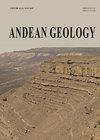Pie de Palo山脉(Sierra Pampeanas, Argentina)高梯度P/T变质作用:法马提安古宙矿物相平衡模拟和地球动力学意义
IF 1.2
4区 地球科学
Q3 GEOLOGY
引用次数: 2
摘要
Sierra de Pie de Palo(SPP,West Sierras Pampeanas)显示了两种区域变质作用的证据:一种是属于格伦维尔造山运动的中元古代,另一种是与法马汀造山运动有关的奥陶纪。覆盖格伦维尔期基底的新元古代至寒武纪沉积序列仅记录了奥陶纪事件。SPP东南侧采集的埃迪卡拉纪Difunta Correa变质沉积序列中的一片十字石片岩,可通过假剖面限制从约3kbar和515ºC到约9kbar和640ºC的前进演化,对应于高P/T梯度。SPP和紧邻东部的Loma de Las Chacras露头是法马汀阶前弧的一部分,该前弧显示P(从约13 kbar到6 kbar)、T(从约900ºC到450ºC)和P/T梯度(从约85ºC/kbar到35ºC/kbal)向西部活动大陆边缘逐渐降低。位于SPP西侧的Caucet群代表弧前最西部,靠近活动大陆边缘。变质作用显然与大约470-465Ma的法马汀期岩浆作用和韧性低推力同时发生,这导致弧前埋藏在岩浆弧下。本文章由计算机程序翻译,如有差异,请以英文原文为准。
Metamorfismo de alto gradiente P/T en la Sierra de Pie de Palo (Sierras Pampeanas, Argentina): modelado de equilibrio de fases minerales e implicancias geodinámicas en el antearco famatiniano
The Sierra de Pie de Palo (SPP, Western Sierras Pampeanas) shows evidence of two regional metamorphisms: one Mesoproterozoic attributed to the Grenvillian orogeny and other of Ordovician age related to the Famatinian orogeny. The Neoproterozoic-to-Cambrian sedimentary successions that cover the Grenvillian basement only record the Ordovician event. One staurolite-schist from the Ediacaran Difunta Correa Metasedimentary Sequence collected in the southeastern side of the SPP allows to constrain, by means of pseudosections, a prograde evolution from ca. 3 kbar and 515 ºC up to ca. 9 kbar and 640 ºC corresponding to a high P/T gradient. The SPP and the immediately east Loma de Las Chacras outcrop were part of the famatinian forearc which shows a progressive decrease of P (from ca. 13 kbar to 6 kbar), T (from ca. 900 ºC to 450 ºC), and P/T gradient (from ca. 85 ºC/kbar to 35 ºC/kbar) towards the active continental margin on the west. The Caucete Group, in the western side of the SPP, represents the westernmost part of the forearc, near to the active continental margin. Metamorphism was apparently coeval with the Famatinian magmatism and with ductile underthrusting at ca. 470-465 Ma, which led to burial of the forearc beneath the magmatic arc.
求助全文
通过发布文献求助,成功后即可免费获取论文全文。
去求助
来源期刊

Andean Geology
地学-地质学
CiteScore
3.90
自引率
0.00%
发文量
17
审稿时长
>12 weeks
期刊介绍:
This journal publishes original and review articles on geology and related sciences, in Spanish or English, in three issues a year (January, May and September). Articles or notes on major topics of broad interest in Earth Sciences dealing with the geology of South and Central America and Antarctica, and particularly of the Andes, are welcomed.
The journal is interested in publishing thematic sets of papers and accepts articles dealing with systematic Paleontology only if their main focus is the chronostratigraphical, paleoecological and/or paleogeographical importance of the taxa described therein.
 求助内容:
求助内容: 应助结果提醒方式:
应助结果提醒方式:


